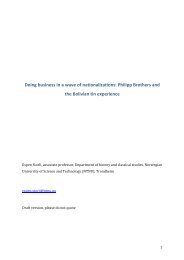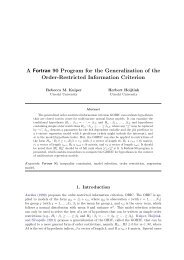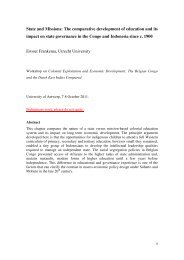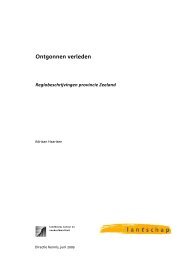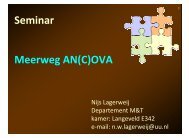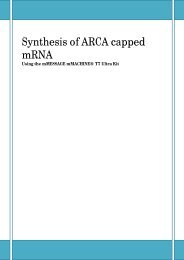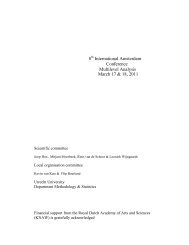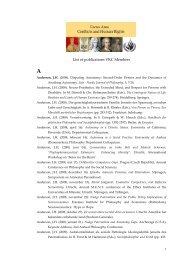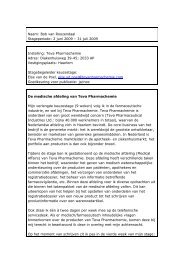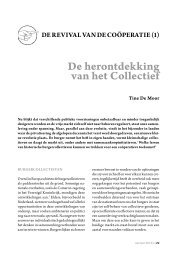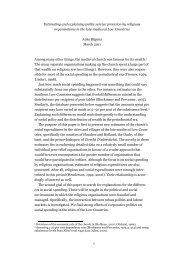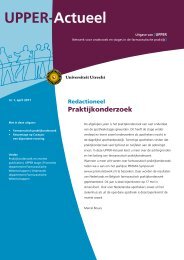New Approaches to Medieval Communication?1
New Approaches to Medieval Communication?1
New Approaches to Medieval Communication?1
You also want an ePaper? Increase the reach of your titles
YUMPU automatically turns print PDFs into web optimized ePapers that Google loves.
24 MARCO MOSTERTsion of saga knowledge; 28 on the literacy of the late medieval Yorkshiregentry; 29 on Anglo-Saxon England; 30 on the Lollards; 31 Byzantium; 32 late medievalFlorence and Venice; 33 ... The list is almost endless. Simultaneously, attemptswere made by medievalists <strong>to</strong> further refine the concept of literacy, forinstance by adding adjectives <strong>to</strong> it. Thus we have visual, female, lay, cultural,early, professional, runic, Jewish, verbal, Christian, pragmatic and religiousliteracy. 34 In most cases the use of an adjective is elucidating; in some it createsmetaphors for something which ought not <strong>to</strong> be termed literacy. It is merelyevidence of the use of the current buzzword.Quite often ‘literacy’ is used in opposition <strong>to</strong> ‘orality’. ‘Oral’ has beencommon <strong>to</strong> denote spoken as opposed <strong>to</strong> written modes of communication fora long time. 35 The techniques of ‘oral tradition’, the transmission of knowledgewithout recourse <strong>to</strong> writing, have been a preoccupation of his<strong>to</strong>rians and literaryhis<strong>to</strong>rians for some time. 36 The use of the term, however, seems relativelyrecent. Spencer Cosmos used it in 1977 in his study of Bede’s Life of St.Aidan. 37 Since then, among other things due <strong>to</strong> the influence of the Belgiananthropologist Vansina, who was trained as a medieval his<strong>to</strong>rian, 38 the term hasbecome current. In 1986 a journal called Oral Tradition started <strong>to</strong> appear. 39The word ‘orality’ seems <strong>to</strong> appear in medieval studies as late as 1986,when Evelyn Birge Vitz uses it in a study of the Old French oc<strong>to</strong>syllabic couplet.40 She explicitly refers <strong>to</strong> Walter J. Ong’s synthesis of 1982, Orality andLiteracy: The Technologizing of the Word. 41 Ong can indeed be said <strong>to</strong> havedone for orality what Goody and Watt did for literacy. In the third chapter of28 No. 328 (TOMMASSON, 1975).29 No. 302 (VALE, 1976).30No. 291 (WORMALD, 1977).31 No. 1509 (ASTON, 1977).32 No. 175 (BROWNING, 1978).33No. 252 (HYDE, 1979).34Visual: No. 410 (MCCLINTOCK, 1981); lay: No. 258 (LAWRENCE, 1985); cultural: No. 44(GATCH, 1986); early: Nos. 306 (HARVEY, 1987) and 333 (FRANKLIN, 1987); professional:No. 768 (GONZALEZ CASANOVAS, 1990); runic: No. 284 (DEROLEZ, 1990); Jewish: No. 343(REIF, 1990); verbal: No. 422 (DIEBOLD, 1992); female: No. 1116 (MCKITTERICK, 1992);Christian: No. 342 (BEDOS-REZAK, 1993); pragmatic: No. 1137 (ed. BRITNELL, 1996); religious:No. 1519 (RITARD, 1997).35Cf., e.g. No. 1280 (CURSCHMANN, 1967).36Nos. 651-722, 205, 327, 1531.37No. 1531.38 Nos. 647-649.39No. 667.40 No. 1389 (VITZ, 1986).41 No. 129 (ONG, 1982); No. 1389 (VITZ, 1986), p. 300.



